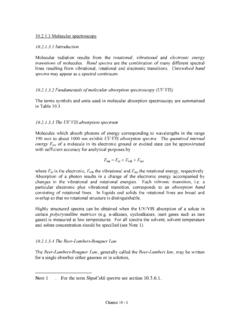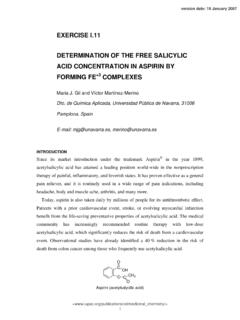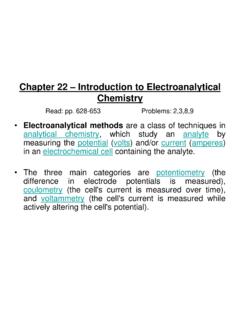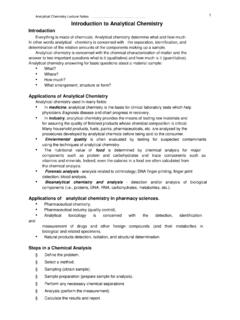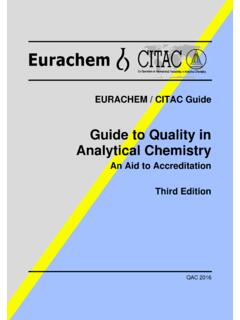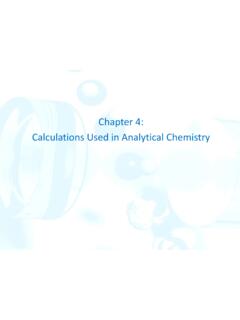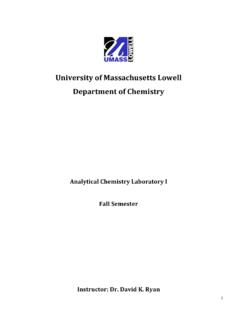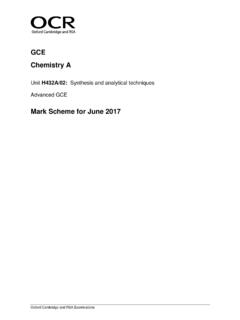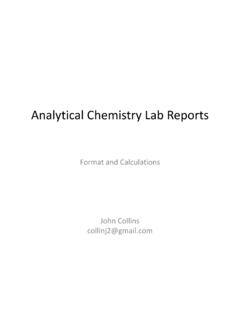Transcription of Selectivity in Analytical Chemistry
1 Selectivity in Analytical Chemistry Recommendations for its UsePoster presented at the IUPAC Congress/General AssemblyJuly 2001 Evolution of the terminologyThe use of the term Selectivity has evolved in parallel with thedevelopment of more sensitive and discriminating methods that canquantify analytes with less interference from other componentsthan earlier methods were able to do. Modern methods oftencomprise several strategies that introduce their own Selectivity toreduce interferences. In this way, highly selective methods can correct use of the term Selectivity and its clear distinctionfrom the term specificity are discussed. Selectivity interactionsSeveral kinds of interactions are used in the Selectivity -generatingsteps leading to the final interactions are, ,chemical reactionsassociate formationadsorption to surfacesinclusion phenomenaabsorption of radiationbiochemical (immunochemical or enzymatic), orelectrochemical (redox) principlesSelectivities in methodsCurrent Analytical methods are based on multistage separation anddetection are often determined with methods based on detectionselectivity, , atomic emission techniques for all types of species rely on Selectivity inthe separation process, separation techniques, like LC-MS, combining selectivities withrespect to detection and separation, are applied when the demandsfor Selectivity are especially high.
2 The addition of tandem massspectrometry, LC-MS-MS, yields a Selectivity that is rarelycompromised and often required in legal from combinations or arrays of sensors with differentdegrees of selectivities have in recent years been evaluated in themathematical domain, often called computational Selectivity .The handling of near infrared spectra using the whole spectrumover a wavelength range is a good example, where otherwiseimportant information would not have been possible to extract. Thespectroelectrochemical detector represents a single sensor withincorporated multimode selectivities that overcomes in methods (cont.)Semantic aspectsSelectivity has its origin in seligo, which is Latin for to choose or to select .Thus selective can mean tending to choose carefully andselectivity, the state or quality of being selective.
3 By combining these two expressions, a useful concept can befound for what actually Selectivity is all about viz, Selectivity isthe state of choosing carefully . This expression very well fitsthe principles by which modern Analytical methods are selectivityIn the current Analytical literature, Selectivity is very oftenexpressed in combination with words such as adjustment, tuning,optimization, predetermined, enhancement, and coefficients, aswell as selective expressions indicate that Selectivity is regarded as somethingthat can be graded. Methods have often been described inqualitative terms, such as having good Selectivity or even high,excellent, or extreme Selectivity . This qualitative use of the termhas been of degree of selectivitySome attempts have been made in the literature to quantifyselectivity (and even specificity).
4 One of the first treatments wasmade by Kaiser. He also distinguished between the use ofspecificity for single analyte analysis and Selectivity , when severalanalytes were demanding procedures have been proposed for calculationswhere a sensitivity factor matrix, K, is involved with n sensorresponses for m components. An approach that will be helpful forthe practicing Analytical chemist with a complex sample still has tobe or specificityThe terms Selectivity or specificity are in many cases usedinterchangeably. As specificity is considered as an absolute term, itcannot be graded. IUPAC has earlier stated that specificity is theultimate of Selectivity .The desire to avoid the term specificity has been expressed as Sometimes the term specificity is used. This usage suggests that nocomponent other than the analyte contributes to the result.
5 Hardlyany method is that specific (sic!) and, in general, the term shouldbe avoided .The frequent use of Selectivity in prestigious journals reflects thissituation but nowhere is a recommendation in Notice forauthors Recommendation1. That the term Selectivity be promotedSelectivity is the recommended term in Analytical Chemistry toexpress the extent of interferences. To avoid confusion, the useof the term specificity is to be discouraged, as it is incorrect. Amethod is either specific or not. Few, if any, methods Definition of SelectivitySelectivity refers to the extent to which a method can determineparticular analytes in mixtures or matrices without interferencesfrom other submitted to public review comments until 30 September by J. Vessman, Stefan, Van Staden, K. Danzer, W. Lindner, Burns, A. Fajgelj, and H.
6 M ller


